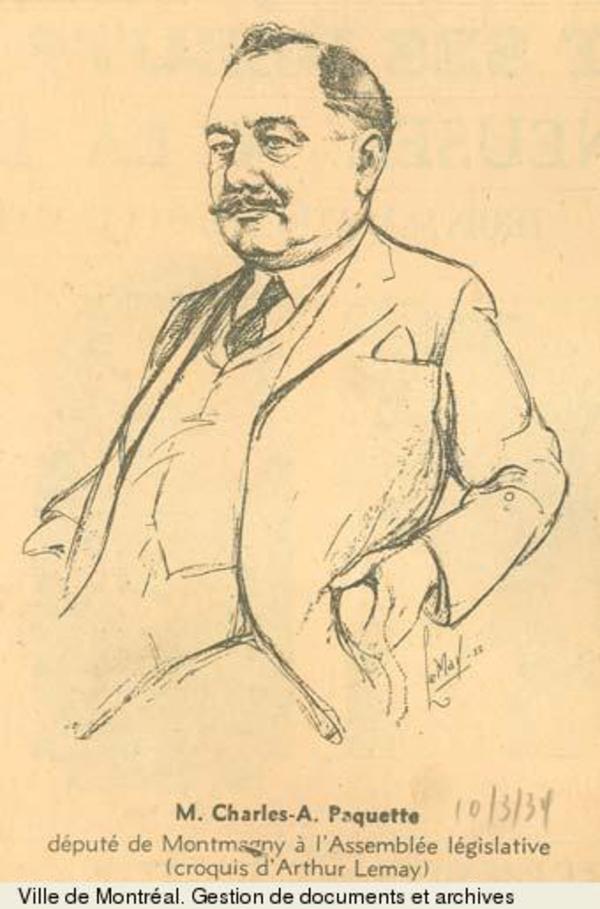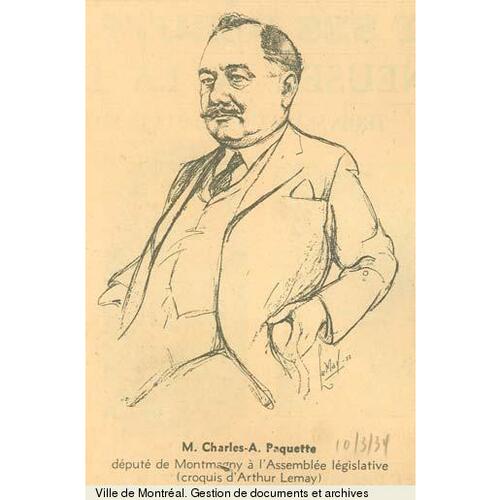
Source: Link
PAQUET, CHARLES-ABRAHAM (baptized Joseph-Charles-Abraham), businessman, politician, and office holder; b. 28 March 1868 in Quebec City, son of Jean-Pierre-Célestin Paquet, a merchant, and Marie-Louise Noël; m. there first 5 July 1892 Mathilda Cloutier in the parish of Saint-Roch, and they had ten children; m. there secondly 28 Jan. 1918 Marie-Jeanne Langlais in the parish of Saint-Jean-Baptiste, and they had five children; d. there 8 Oct. 1936 and was buried in Notre-Dame de Belmont cemetery, Sainte-Foy (Quebec City).
Little is known about Charles-Abraham Paquet’s youth. He is believed to have had elementary schooling in Sainte-Jeanne-de-Neuville (Pont-Rouge) or in Sainte-Catherine (Sainte-Catherine-de-la-Jacques-Cartier). Then, for a short time around 1887 he attended the Académie Commerciale de Québec, run by the Brothers of the Christian Schools.
Following in his father’s footsteps, Paquet began his career in the retail trade in Quebec City. In 1891–92 he advertised himself as a dairyman and was selling flour on the Chemin Sainte-Foy. Some years later, in 1898, he was an agent for the Canadian Dairy Supply Company, and in 1900–1 he began retailing equipment for butter factories. In 1901 Paquet and 14 other partners, including Joseph-Édouard Caron*, who later became provincial minister of agriculture, conceived the idea of exploiting the rich industrial potential of the Saguenay–Lac-Saint-Jean region. They founded the Métabetchouan Pulp Company, a pulp and paper business, and opened a factory in Saint-André (Saint-André-du-Lac-Saint-Jean), which is thought to have soon burned down. The project was ambitious and the results fell short of expectations. In 1907 the company would have to reach an agreement with the shareholders to avoid liquidation.
On 8 Sept. 1902 Paquet and four partners founded the Compagnie Charles A. Paquet in Quebec City. It sold machinery, accessories, and general hardware. Paquet, who was well known in the provincial Liberal Party, obtained lucrative contracts, in particular for road-construction equipment. This success was probably what led the company, on 17 April 1907, to expand its activities to include the manufacture of machines and accessories. The first order, “20 engines of 10 to 100 horsepower,” to be delivered on 20 May, was subcontracted to the Compagnie Manufacturière de Montmagny. Thus the two enterprises began to collaborate. In 1911, after the Compagnie Manufacturière de Montmagny made the investments necessary to carry out another contract for the Compagnie Charles A. Paquet, it was left in such a precarious position that its directors tried to find a buyer for it.
In the end, on 22 Oct. 1912, Paquet founded Usines Générales de Chars et de Machineries Limitée in Montmagny with four partners, among them Arthur-Napoléon Normand, the manager of the Compagnie Manufacturière de Montmagny. In December the assets of the latter company were transferred to the new enterprise. Usines Générales had an authorized capital of $500,000, which it would increase to $1 million. According to its letters patent, it had numerous objectives, which included erecting industrial buildings, producing electricity, dealing in real estate, and manufacturing vehicles. On 4 Nov. 1912 the City of Montmagny, seeing the company as a factor in municipal growth, granted it a 20-year tax exemption and a bonus of $25,000, advantages that Paquet had probably counted on and that may have prompted him to set up business there. The factories of the two companies, now merged into one, developed at a steady pace. The workforce grew from 35 in 1910 to 140 in 1913, while the factories’ floor-space increased from 7,876 square feet in 1911 to 28,550 in 1913.
In 1915, as a result of World War I, Paquet obtained lucrative contracts for manufacturing shells. He had to modify one of his factories and repair it, however, after a fire in May 1916 destroyed everything except the foundry. To finance this extensive work, Paquet turned to the Banque Nationale, which had already lent money to the Compagnie Manufacturière de Montmagny. Not wanting to lose its investment, the bank agreed to the industrialist’s request and in 1917 it extended to Usines Générales a loan totalling $2 million, then a considerable sum. Despite this injection of capital, the company was not in a position to complete the work and fell behind schedule. Relations between Paquet and the Banque Nationale became tense, with the bank accusing him of taking an unreasonable salary and bonuses, and of having withdrawn the sum of $11,000 without giving an explanation. The company would manage, nonetheless, to reduce its debt in the course of 1918. In 1917 it had a workforce of 1,050, which was then a record for Montmagny.
Paquet’s activities were not restricted to the commercial and industrial sectors. From the time Usines Générales was founded he had thought about creating a neighbourhood near the company’s factories where the employees could live. To this end he bought a number of lots in the City of Montmagny and the nearby municipality of Saint-Thomas-de-la-Pointe-à-la-Caille (Montmagny). In 1913 he proceeded to subdivide these lots and open streets. Between that year and 1916 Paquet stepped up his efforts to develop this land despite the opposition that the project aroused in certain circles. He finally prevailed in 1916: the lots purchased by Usines Générales in 1912 would become Montmagny’s working-class and industrial district. On 14 June 1916 Paquet, Arthur-Napoléon Normand, Victor-Emmanuel-Pantaléon Hudon, Joseph-Cléophas Hébert, and Maurice Rousseau founded a property-development company, the Compagnie de Construction de Montmagny. Some of the partners were shareholders and directors in Usines Générales, and since 1905 Rousseau had been the owner of the company that supplied water to the city of Montmagny. The lots were now put up for sale.
Paquet’s efforts to make his industrial and real-estate capital yield profits did not stop there. Montmagny’s industrial sector was expanding rapidly in 1918. Yet companies still did not have electricity and they were hampered by a shortage of coal, which was then rationed. On 25 April 1918 a group of prominent citizens, including Hébert and Rousseau, set up a firm to deliver and distribute electricity, the Corporation d’Énergie de Montmagny. Paquet joined the team sometime later. On 1 Jan. 1921, after substantial preparatory work, the corporation would serve its first customer, Paquet’s factory, which in the meantime had changed its name and focus.
When the war had ended, Paquet had, in fact, reorganized the company to adapt its production to a peacetime economy. National Farming Machinery Limited was incorporated on 15 Sept. 1919 with a share capital of $4 million. Armand La Vergne, who had represented the riding of Montmagny federally and provincially, was one of its founders. Paquet became president and chief executive officer. The economic crisis in the agricultural sector and especially the end of government contracts inflicted heavy financial losses on the company. In 1921 it issued bonds worth $2 million and obtained a credit of $1.5 million from the Banque Nationale. At the end of 1921 its total debt to this bank is believed to have reached somewhere between $3.8 million and $4.5 million. In February 1922, unable to meet his financial obligations, Paquet was forced to shut down his factories and on 18 November National Farming Machinery went into bankruptcy. Montmagny was badly hit by this closure. According to the city council, 2,000 people left between 1922 and 1924. The Banque Nationale was also hard-pressed by the company’s insolvency, which plunged it into a difficult, indeed precarious, financial situation [see Georges-Élie Amyot*]. The unfortunate episode was echoed even in the field of literature. It gave Jean-Charles Harvey*, who had been a publicist at National Farming Machinery, the inspiration for his novel Marcel Faure (Montmagny, 1922). Despite this sensational failure, Paquet continued to live in Montmagny, where he had settled in late 1915 or early 1916, but he was now less active. In 1930, with Hébert, Rousseau, and others, he helped persuade an American textile manufacturer, the M. E. Bintz Company Limited, to establish itself in the region. Their efforts were crowned with success and the factory opened on 17 Oct. 1931.
Alongside his career in business, Paquet tried his hand at politics. In 1913 he was a municipal councillor for Montcalm (Quebec City). After this town was annexed at the end of the year, he held the same office at the Quebec city hall from 1914 to 1916, though he was not very involved. In the provincial election of 1919 he became the Liberal mla for the riding of Montmagny, and he won the seat again in 1923, 1927, and 1931. Paquet ended his career as an inspector with the Department of Colonization. He died on 8 Oct. 1936 at the home of Adélard Godbout*, a past and future premier of Quebec.
Charles-Abraham Paquet was an ambitious businessman who was enterprising and eager to find new challenges. His career illustrates how some entrepreneurs in the early 20th century increased their industrial capital by promoting real-estate development as well. He found an effective way to link his private interests to the public interest, in particular by working with other local businessmen who had connections to elected municipal politicians. His bad choices, lack of caution, and overweening ambition certainly militated against him. Nevertheless, like better-known promoters such as Alphonse Desjardins* and Charles-Théodore Viau*, he played a prominent role in turning his community into a modern industrial and urban regional centre, with factories, residential complexes, and municipal services.
AVQ, M1 (organismes municipaux, annexions), 3 (ville de Montcalm), procès-verbaux; QP1 (ville de Québec, politique, conseil), 4 (conseils et comités), 41/4 (échevins: Paquet à Plamondon). BANQ-Q, CE301-S22, 5 juill. 1892; CE301-S97, 28 mars 1868. FD, Saint-Jean-Baptiste (Québec), 28 janv. 1918. Le Devoir, 8 oct. 1936. Le Peuple (Montmagny, Québec), 26 mars 1906; 20 janv. 1911; 5 févr., 3 déc. 1915; 13 mai, 16, 30 juin 1916; 15 juin 1917; 23 juin, 1er déc. 1922; 6 févr. 1925. Le Soleil, 10 févr. 1919, 8 oct. 1936. BCF, 1933: 180. Canada Gazette, 27 Sept. 1919: 972–73. Martine Côté, “Industrialisation et urbanisation à Montmagny, 1883–1930” (mémoire de ma, univ. Laval, Québec, 1990). DOLQ, 2: 658–60. DPQ. Yves Hébert, Montmagny et la Côte-du-Sud (Québec, 2005), 52–53; Montmagny … une histoire, 1646–1996: la seigneurie, le village, la ville ([Montmagny], 1996). Histoire de la Côte-du-Sud, sous la dir. d’Alain Laberge (Québec, 1993). Que., Statutes, 1902, c.78; 1907, c.106. Quebec Official Gazette, 1901: 985; 1902: 841–42, 1571; 1907: 731; 1912: 2301–2; 1916: 1696–97; 1918: 975–77. Ronald Rudin, Banking en français: the French banks of Quebec, 1835–1925 (Toronto, 1985). Rumilly, Hist. de la prov. de Québec, vol.17: 25, 35.
Cite This Article
Martine Côté, “PAQUET, CHARLES-ABRAHAM (baptized Joseph-Charles-Abraham),” in Dictionary of Canadian Biography, vol. 16, University of Toronto/Université Laval, 2003–, accessed January 2, 2025, https://www.biographi.ca/en/bio/paquet_charles_abraham_16E.html.
The citation above shows the format for footnotes and endnotes according to the Chicago manual of style (16th edition). Information to be used in other citation formats:
| Permalink: | https://www.biographi.ca/en/bio/paquet_charles_abraham_16E.html |
| Author of Article: | Martine Côté |
| Title of Article: | PAQUET, CHARLES-ABRAHAM (baptized Joseph-Charles-Abraham) |
| Publication Name: | Dictionary of Canadian Biography, vol. 16 |
| Publisher: | University of Toronto/Université Laval |
| Year of publication: | 2014 |
| Year of revision: | 2014 |
| Access Date: | January 2, 2025 |



